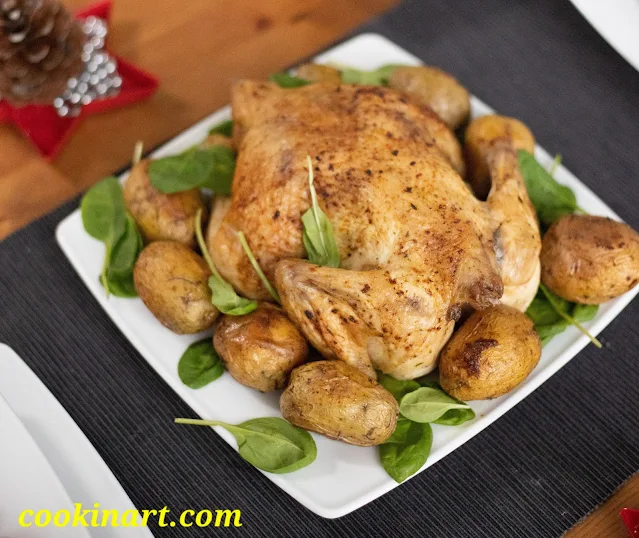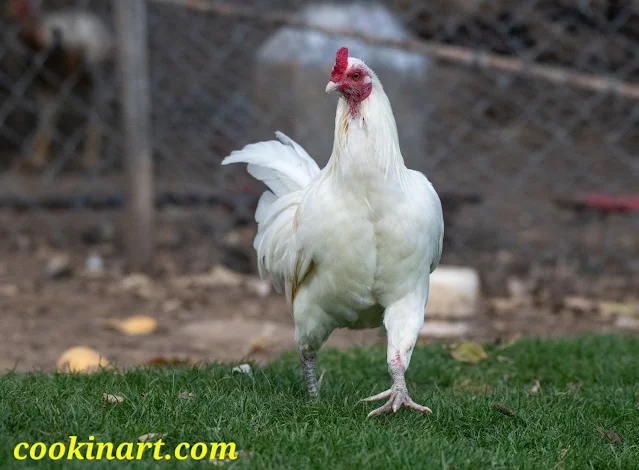Cooking a whole chicken is a culinary adventure that offers a delightful array of flavors and textures. From crispy skin to succulent meat, a well-prepared roast chicken is a gastronomic delight. In this article, we will guide you through the process of cooking a whole chicken while discussing the benefits and potential considerations of incorporating chicken into your diet.

|
| The art of roasting a whole chicken, benefits, considerations and types. |
Part 1: The Benefits of Chicken
-1. Nutrient-Rich Protein
Chicken is a superb source of high-quality, lean protein. Protein is essential for the growth and repair of tissues in the body. A 3.5-ounce serving of chicken breast can provide more than 30 grams of protein, making it an excellent choice for those looking to meet their daily protein needs.
-2. Versatile Ingredient
Chicken's neutral flavor and adaptable nature make it a versatile ingredient for various cuisines and cooking techniques. From hearty stews to spicy curries and, of course, the classic roast chicken, this poultry can be the star of your meal.
-3. Essential Nutrients
In addition to protein, chicken also contains essential nutrients such as vitamin B6, B12, niacin, and selenium. These vitamins and minerals play a crucial role in maintaining overall health, supporting the immune system, and promoting nerve function.
-4. Weight Management
Chicken is lower in fat than many other meats, making it a favorable choice for those seeking to manage their weight. The lean protein content can help you feel full and satisfied, which may assist in curbing unnecessary snacking.
Part 2: Cooking a Whole Chicken
Now that we've explored the benefits of chicken, let's delve into the art of cooking a whole chicken:
-1. Selecting the Chicken
Choose a fresh, high-quality whole chicken from a reputable source. Look for plump, well-textured skin and a pleasant, fresh aroma. The size of the bird should suit your needs and the number of diners.
-2. Preparing the Chicken
Thoroughly wash the chicken and gently blot it dry using paper towels. Season the bird generously with your choice of herbs, spices, and oil or butter. Don't forget to season the cavity for extra flavor.
-3. Roasting
Place the chicken on a roasting rack in a preheated oven at around 350°F (175°C). Roasting time will depend on the size of the bird, but it's generally about 20 minutes per pound (450 grams). Ensure the internal temperature reaches 165°F (74°C) for safe consumption.
-4. Resting
Allow the roasted chicken to rest for 15-20 minutes before carving. This step is essential to retain the juices, ensuring a moist and flavorful outcome.
Part 3: Considerations
While chicken offers numerous benefits, it's crucial to be aware of certain considerations:
●1. Contaminants
Proper handling and cooking are vital to prevent foodborne illnesses associated with chicken. Always follow food safety guidelines, such as washing hands, utensils, and surfaces, and avoiding cross-contamination.
●2. Harmful Fats
Chicken skin, while delicious, contains saturated fats. If you're concerned about saturated fat intake, consider removing the skin or choosing lean cuts like chicken breast.
●3. Cooking Methods
The healthiness of your chicken dish can be influenced by the cooking method. Roasting, grilling, or poaching are healthier options compared to deep-frying.
Conclusion
Cooking a whole chicken is a culinary experience that comes with an array of benefits, from being a rich source of protein to its versatility in the kitchen. However, it's essential to consider factors like food safety and the cooking method when incorporating chicken into your diet. With the right approach, you can enjoy the deliciousness of a perfectly roasted chicken while reaping its nutritional rewards.
Exploring the Diverse World of Chicken Varieties
Chicken, the world's most widely consumed meat, comes in a variety of breeds and varieties, each with its unique characteristics, flavors, and purposes. In this exclusive article, we will embark on a journey to explore the fascinating world of chicken types, shedding light on some well-known and lesser-known breeds that enrich our culinary experiences.
1. The Classic Chicken: The Plymouth Rock
The Plymouth Rock, often referred to as the Barred Rock, is a quintessential American breed known for its friendly temperament and practicality. Recognizable by its black and white striped feathers, it's prized for its versatile egg-laying abilities and flavorful meat. Whether you're after brown eggs for breakfast or a roast for dinner, the Plymouth Rock delivers.
2. The Exquisite Ornamental: The Silkie
Silkies are a unique and ornamental breed characterized by their fluffy plumage, blue-black skin, and five toes. Their sweet disposition and striking appearance make them a popular choice among backyard poultry enthusiasts. While their small eggs are less prolific than some other breeds, their meat is tender and highly regarded in certain culinary traditions.
3. The Egg Maven: The Leghorn
Leghorns are best known for their prolific egg production. These birds lay white eggs regularly, making them a top choice for those seeking a consistent source of fresh eggs. They're also known for their active and alert nature, with various plumage colors to choose from, including the classic white Leghorn.
4. The Dual-Purpose Delight: The Rhode Island Red
Rhode Island Reds are a dual-purpose breed renowned for both their brown eggs and succulent meat. They are robust, hardy birds with a gentle disposition, making them an excellent choice for beginners and experienced poultry keepers alike. Their rusty-red feathers and reliable production make them a staple in many American farms.
5. The French Gourmet: The French Marans
Hailing from the French town of Marans, these birds are famous for their rich, dark brown eggs. Their striking dark feathers and friendly temperament make them a popular choice for backyard flocks, especially among those who appreciate the culinary art of creating dishes with deep-hued yolks.
6. The Ornate Showstopper: The Frizzle
The Frizzle's defining feature is its unique and captivating frizzled feathers, which curl outward instead of lying flat. While these birds may not be the most prolific egg layers, they are a popular choice among poultry enthusiasts who value their quirky appearance and friendly personalities.
7. The Quirky Feathered Friend: The Polish
Polish chickens, with their striking and often humorous-looking crests of feathers, are a delightful addition to any flock. These birds are known for their gentle disposition and add a touch of whimsy to your backyard. Their egg-laying abilities vary, but their unique appearance is what truly makes them stand out.
Conclusion
The world of chicken varieties is a vast and diverse one, offering an array of choices for poultry enthusiasts, whether for eggs, meat, or ornamental purposes. Exploring the different breeds of chickens can be an enriching experience, both in terms of culinary diversity and the charming personalities they bring to your backyard. Each breed has its unique qualities, making the world of chicken keeping a delightful journey for those who embark upon it.
